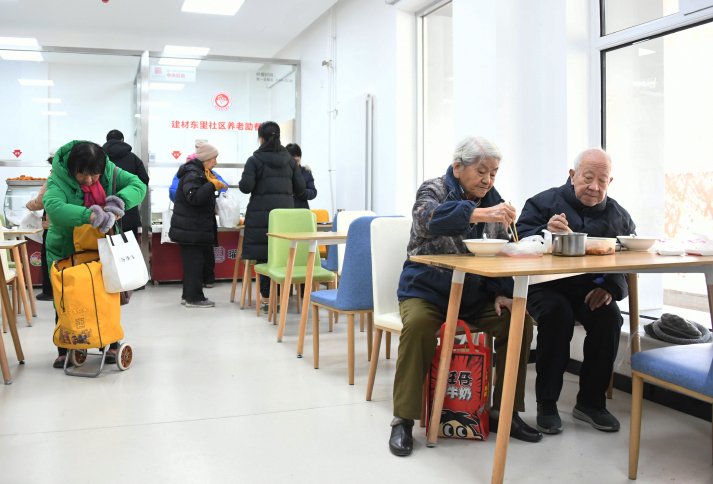| China |
| The positive and negative effects of a demographic decrease | |
|
|
 A nurse takes care of newborns at a hospital in Nanjing, Jiangsu Province, on September 30, 2023 (XINHUA)
China's overall population fell for a second year in a row in 2023. The National Bureau of Statistics (NBS) announced on January 17 that China's population shrank by 2.08 million year on year to around 1.41 billion over the course of the year.
The number of babies born last year decreased by about 540,000 year on year to 9.02 million, whereas 11.1 million deaths were recorded over the same period. In 2022, China's population dropped by 850,000 year on year, marking the first negative population growth since 1961.  Seniors eat at a community canteen for the elderly in Beijing on January 16 (XINHUA)
Causes of the decline The population declined by a larger margin last year due to factors including a reducing number of women of childbearing age, a declining willingness to have children, postponement of marriage and birth, and an increasing number of people choosing to not have children, Yuan Xin, a professor of demography at Nankai University's School of Economics and Vice President of the China Population Association, told Haibao News, a news portal based in Shandong Province. The negative population growth might ease this year as more people may choose to give birth in 2024, the Year of the Dragon, which symbolizes good fortune in China's zodiac system, and as births rebound after the three-year COVID-19 pandemic. However, according to the China Development Report 2023, released in December last year by the Development Research Center of the State Council, the highest state administration organ, the country's overall population will maintain a downward trend for a long time to come. The drop in birth rate will continue to be the primary reason for China's population decline. The report said in 1990, China entered a period of slow population growth characterized by low birth rate and low death rate. China's death rate has remained stable since 1965, standing between six to eight deaths per 1,000 people, while the birth rate fell from 33.6 births per 1,000 people on average in the 1960s to 17.6 births per 1,000 people on average in the 1990s. It had further dropped to 6.39 births per 1,000 people by 2023. As long as the birth rate continues to remain low, the negative population growth will continue, Jin Niu, a lecturer in population economics at the School of Public Finance and Administration at Tianjin University of Finance and Economics, told financial news outlet Yicai. Pros and cons Population decline has positive effects, including potentially reducing pressure on resources and the environment and easing employment pressure. The report said population reduction and age structure change will change the supply and demand of the labor market in the middle and long term, improving employees' bargaining power and wages. As the number of young people entering the job market reduces in the future, youth unemployment, especially among college graduates, will decrease. Negative effects of population decline include impacts on labor-intensive enterprises, increasing pressure on pension systems and an increased proportion of people requiring support in old age. The report showed that senior citizens aged 65 or above account for 14.9 percent of the population at present, indicating China has become a moderately aging society. According to international standards, when the proportion of people aged 60 or above accounts for 20-30 percent, or the proportion of people aged 65 or above is 14-20 percent of the total, the region is considered to be a moderately aging society. By 2030, the population aged 65 or above will rise to 20.3 percent of the total population and China will become a severely aging society. The report said China has more than 30 million elderly people living alone and more than 40 million elderly people with disabilities or partial disabilities. China's senior care industry is still in its early stages and there is a shortage of professionals to work in rehabilitation hospitals and nursing homes, and in home-based elderly care. Solutions To cope with the aging population, the State Council recently released a guideline encouraging companies and industry participants in sectors including healthcare, tourism and financial consultancy to optimize their services and products for the elderly. The guideline said the "silver economy"—economic activities offering products or services for the elderly—has great potential that has yet to be fully tapped because of the large and increasing size of the market and the diversity of industries involved. According to the guideline, hospitals and other healthcare institutions are encouraged to build capacity to treat geriatric diseases and improve rehabilitation services for the elderly. Senior-oriented hi-tech products such as domestic nursing robots and rehabilitation assistance devices should be developed and promoted, the guideline said. In addition to calling for improvement in domestic services, the guideline also encourages travel agencies and cultural companies to develop more products that cater to the needs of the elderly. The report suggested continuing to capitalize on the large proportion of working population. China will still have a large overall population and working-age population for a long time to come and further unleashing the potential of the large working population is the most direct and effective strategy of reducing the negative impact of population decline. Measures may include increasing the rate of employment and relaxing hukou, or household registration, rules, to facilitate the relocation of migrant workers to cities. Moreover, China has adjusted its family planning policy several times in recent years, allowing all couples to have two children since 2016 and to have three children since May 2021. Central and local governments have unveiled a slew of measures to support child birth, including building more nonprofit kindergartens, extending maternity leave and providing financial subsidies for multi-child families. However, Yuan said it's uncertain how effective these policies will be in boosting birth rate and stabilizing population. "The costs of child rearing can affect the willingness to have a child, but cultural changes are also important factors," he said. Many of those aged 60 or above share the values that "more children means greater happiness" and of "bringing up children to support parents in old age." In their view, a family without children is incomplete. In contrast, the younger generation, especially those born after 1990, who constitute the main group of people of childbearing age today, put more emphasis on self-development, rejecting factors that may hinder it, including marriage and having children. Yuan said the change of perceptions might take one to two generations and supporting policies are unlikely to increase the birth rate overnight. (Print Edition Title: Coping With Population Decline) Copyedited by G.P. Wilson Comments to jijing@cicgamericas.com |
|
||||||||||||||||||||||||||||
|
